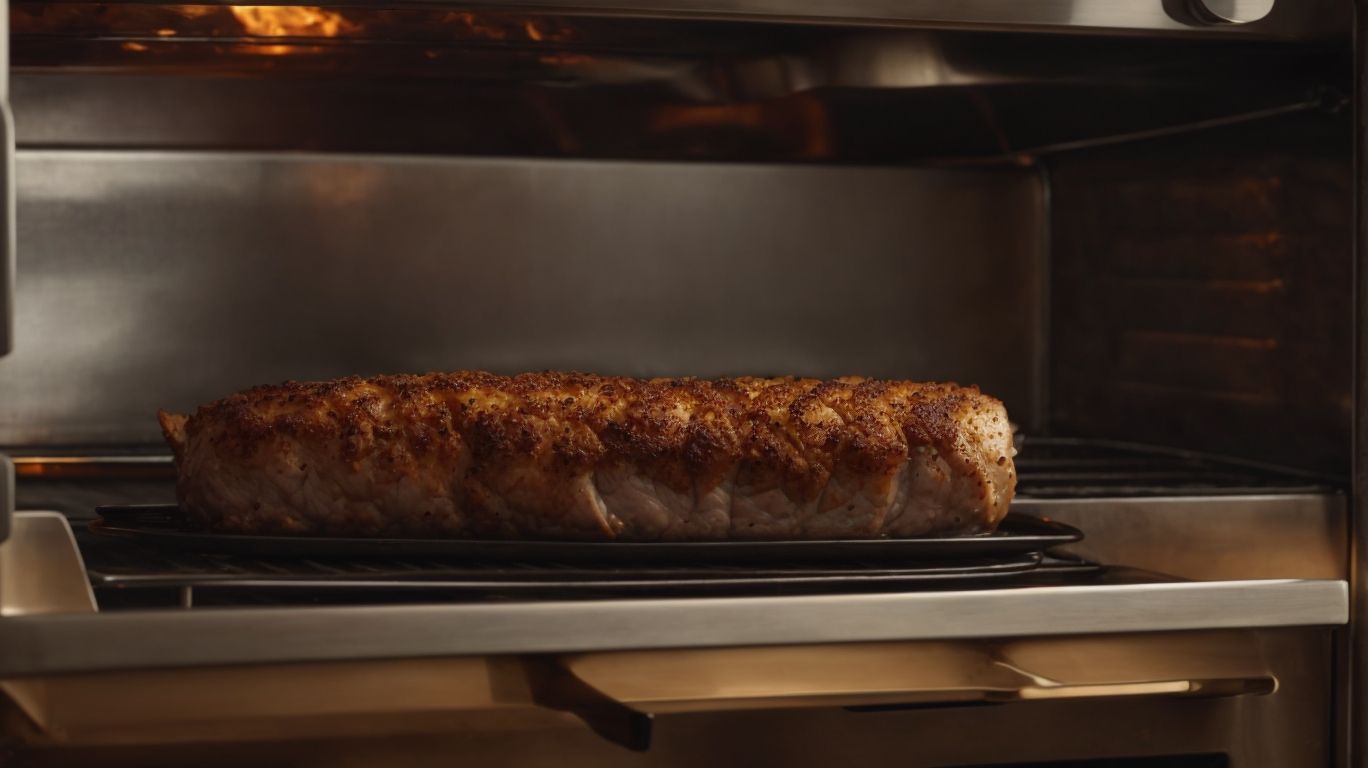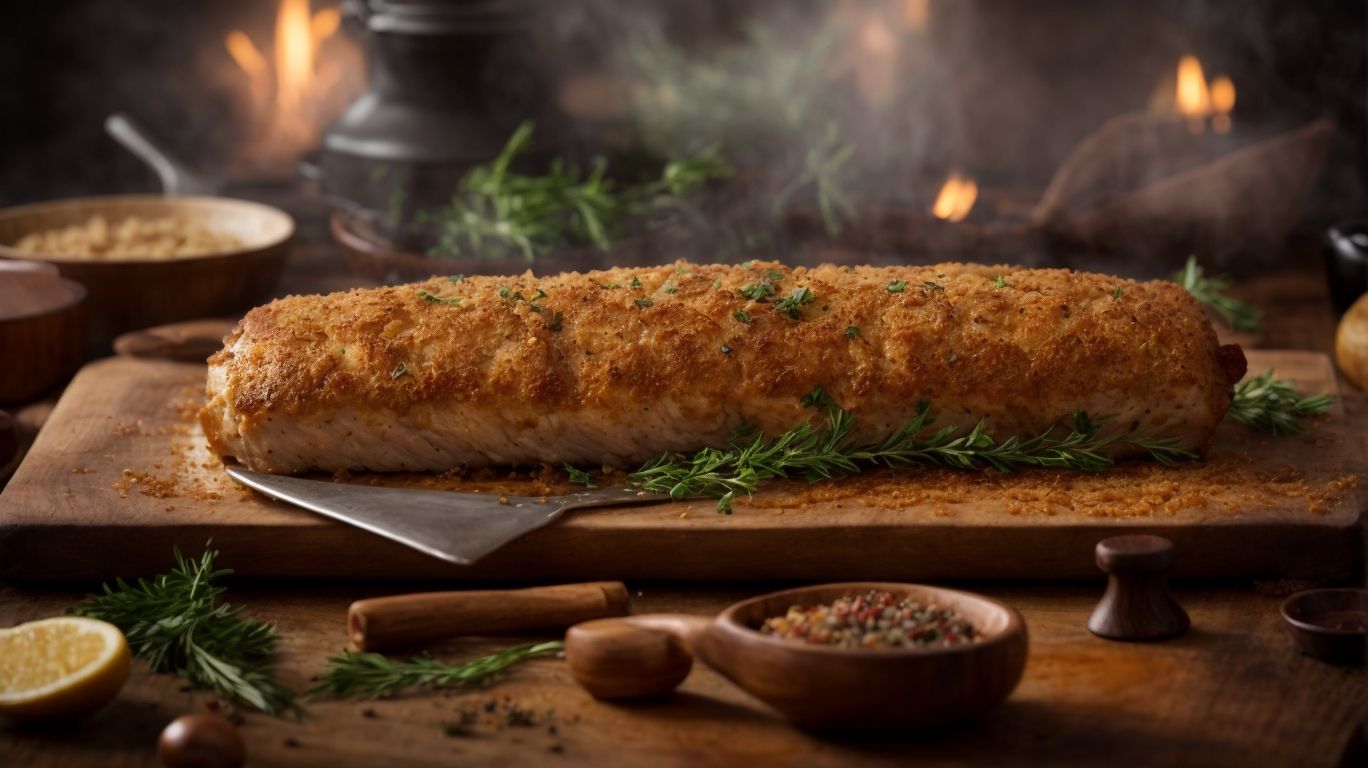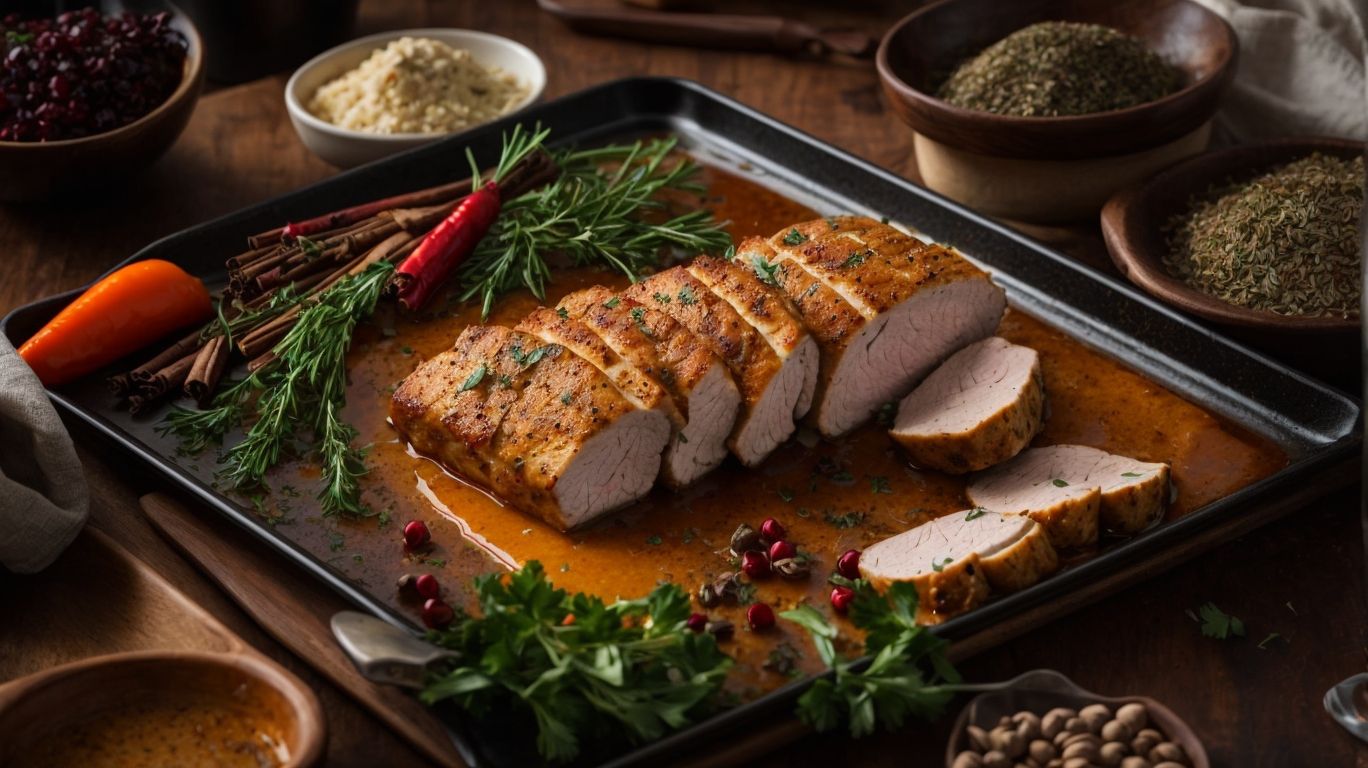How to Bake Pork Tenderloin?
Looking to impress your dinner guests with a delicious and perfectly baked pork tenderloin?
In this article, we will explore everything you need to know about baking pork tenderloin – from the difference between pork tenderloin and pork loin, to the best cuts for baking, to tips for perfectly baked pork tenderloin.
By the end of this article, you’ll have all the knowledge and skills to create a mouthwatering dish that will leave everyone asking for seconds. Let’s get started!
Key Takeaways:
What is Pork Tenderloin?
Pork tenderloin, a lean and tender cut of pork, is a versatile choice for many delicious dishes.
Known for its juicy and tender texture, pork tenderloin is a preferred option due to its versatility in cooking methods. Whether it’s baked pork, grilled, pan-seared, or even slow-cooked, this cut is perfect for various culinary creations.
One popular way to enhance its natural flavors is by marinating it with a seasoning rub before cooking. The key to a perfectly cooked pork tenderloin lies in paying attention to the internal temperature, ensuring it is cooked just right to preserve its tenderness and taste.
What is the Difference Between Pork Tenderloin and Pork Loin?
Understanding the distinction between pork tenderloin and pork loin is essential for selecting the right cut for your culinary creations.
While both cuts of pork come from the same animal, pork tenderloin is a lean and tender piece of meat, which makes it perfect for quick-cooking methods like grilling, roasting, or pan-searing. Its mild flavor allows it to pair well with a variety of seasoning rubs and marinades, making it a versatile choice for dishes ranging from Asian stir-fries to traditional Western recipes.
On the other hand, pork loin is a larger and fattier cut that is excellent for slow-cooking methods such as braising or roasting. It can be further divided into different sections like the center-cut loin roast, sirloin roast, or rib roast, each with its own unique texture and flavor profile.
In terms of cooking, pork tenderloin requires less time and should be cooked to an internal temperature of 145°F, while pork loin benefits from longer cooking times to help render the fat and develop its rich flavor. Whether you’re preparing a quick weekday meal or a festive holiday dinner, understanding the differences between these cuts of pork will help you elevate your cooking game and create delicious dishes that cater to various preferences and occasions.
What You Will Need for Baking Pork Tenderloin
To create a mouthwatering baked pork tenderloin, gather a selection of flavorful spices and the necessary tools for the perfect oven-baked dish.
For the perfect spice blend, you will need garlic powder, cumin, and chili powder to bring out the rich flavors of the pork. The garlic powder adds a savory kick, while the cumin infuses a warm, earthy taste, and the chili powder brings a subtle heat. It’s crucial to have a reliable meat thermometer to ensure the pork reaches the ideal internal temperature for safe consumption. Set your oven to a precise temperature of 375°F to achieve a juicy and tender pork tenderloin. Prep your meat by rubbing the spice mixture generously before placing it in the oven for a delectable dish that will impress your guests.
What are the Best Cuts of Pork Tenderloin for Baking?
Selecting the best cuts of pork tenderloin for baking ensures a juicy and flavorful outcome that will delight your taste buds.
When choosing pork tenderloin for baking, it’s important to consider the different cuts available. The center-cut tenderloin, known for its tenderness and lean quality, is perfect for baking as it cooks evenly and remains juicy. On the other hand, end-cut tenderloin, with its slightly thinner shape, is ideal for quicker cooking methods like grilling or pan-searing.
For a truly mouthwatering result, consider marinating the tenderloin in a savory seasoning rub or fruit juices before baking. These additions add a depth of flavor that complements the natural sweetness of the pork. Always remember to use a meat thermometer to ensure the pork is cooked to perfection, with an internal temperature of 145°F.
What Other Ingredients Should You Have on Hand?
Along with the main pork tenderloin, consider preparing complementary side dishes and keep an eye on storage solutions for any delicious leftovers.
When serving pork tenderloin, side dishes can enhance the overall dining experience. Some popular choices include roasted vegetables such as asparagus, brussels sprouts, or sweet potatoes tossed with olive oil and herbs.
For a starch component, consider serving a wild rice pilaf or garlic mashed potatoes to complement the tenderloin perfectly.
In terms of storing leftovers, make sure to cool the meat quickly before refrigerating. Store in an airtight container in the fridge for up to three days.
If you plan to store leftovers longer, consider freezing them. Wrap individual portions tightly in plastic wrap and aluminum foil to prevent freezer burn. Label with the date to keep track of freshness for up to three months.
Preparing the Pork Tenderloin for Baking
Before baking, proper preparation of the pork tenderloin is crucial to ensure a delectable outcome that will satisfy your culinary aspirations.
Start by trimming any excess fat or silver skin from the pork tenderloin to enhance its tenderness and prevent it from becoming tough during baking.
Next, prepare a seasoning rub consisting of your favorite herbs and spices like garlic, thyme, paprika, and salt to infuse rich flavor into the meat.
Preheat your oven to the recommended temperature of around 375°F (190°C) for pork tenderloin, ensuring even cooking throughout. Utilize a meat thermometer to accurately monitor the internal temperature, allowing you to achieve a perfectly cooked tenderloin.
For added moisture and flavor, consider searing the pork tenderloin in a hot pan before transferring it to the oven. This technique locks in juices and creates a beautiful crust on the exterior.
How to Trim the Pork Tenderloin?
Trimming the excess fat and silverskin from the pork tenderloin is a crucial step in enhancing its tenderness and flavor profile.
One of the key benefits of trimming a pork tenderloin is that it allows for better seasoning penetration, ensuring that your seasoning rub flavors the meat evenly. To effectively trim a pork tenderloin, start by removing the silverskin using a sharp knife, being careful not to cut into the meat itself. Next, trim any visible fat, as excessive fat can lead to flare-ups during cooking. Be mindful of the direction of the grain while trimming to ensure optimal tenderness. Avoid over-trimming, as this can result in a dry and tough end product.
Should You Marinate the Pork Tenderloin?
Marinating pork tenderloin in citrus juices can infuse delightful flavors and tenderness, elevating your culinary creation to new heights.
One of the main advantages of using citrus juices for marinating pork tenderloin is the bright acidity that helps to tenderize the meat and add a refreshing zing to the dish. To make the most of this technique, consider marinating the pork for at least 4-6 hours or even overnight to allow the flavors to fully penetrate the meat.
For an extra depth of flavor, you can also add garlic powder to the marinade, complementing the citrus notes with a savory kick. If you’re looking to experiment with different flavors, try swapping out the citrus juices for a tangy pineapple marinade or a spicy chipotle-lime blend.
In terms of serving suggestions, grilled citrus-marinated pork tenderloin pairs beautifully with fresh salads, roasted vegetables, or even a side of fluffy quinoa. The versatility of this dish makes it a crowd-pleaser at any dinner table.
Baking the Pork Tenderloin

Credits: Poormet.Com – Frank Brown
Achieving the perfect bake for your pork tenderloin requires precise temperature control and monitoring using a reliable meat thermometer.
Preheat your oven to 400°F for a tender and juicy result. Season the pork tenderloin generously with a blend of paprika, salt, and black pepper to enhance its flavors. Once seasoned, place the tenderloin on a lined baking sheet and insert a meat thermometer into the thickest part of the meat for accurate temperature reading.
Cook the pork tenderloin for approximately 20-25 minutes per pound, ensuring the internal temperature reaches 145°F for a perfectly cooked dish. Remember, using a meat thermometer is crucial to avoid under or overcooking, leading to a mouthwatering and succulent pork tenderloin every time.
What is the Best Temperature to Bake Pork Tenderloin?
Determining the optimal baking temperature for pork tenderloin ensures a juicy and flavorful outcome that will leave your taste buds singing with delight.
In terms of baking pork tenderloin, the recommended internal temperature for a perfect juicy result is around 145°F (63°C). Different flavor profiles can be achieved by adjusting the cooking temperature. For a sweeter taste, basting the tenderloin in a fruit juice mixture while baking at a slightly lower temperature can infuse it with a delightful sweetness. On the other hand, higher baking temperatures of around 400°F (204°C) can create a nice sear on the outside while keeping the meat tender inside.
How Long Should You Bake Pork Tenderloin?
The cooking duration plays a vital role in determining the succulence and tenderness of your baked pork tenderloin, so it’s essential to time it just right.
When baking pork tenderloin, it’s imperative to consider the size of the cut. For smaller tenderloins weighing around 1 pound, the baking time typically ranges between 20-25 minutes at 425°F for a perfectly juicy result.
On the other hand, larger tenderloins, weighing 1.5-2 pounds, may require 25-30 minutes in the oven to achieve that ideal balance of a crisp exterior and moist interior. To ensure your pork reaches the desired doneness, invest in a reliable meat thermometer to accurately monitor the internal temperature, which should read about 145°F for safe consumption.
How to Tell When Pork Tenderloin is Done?
Using a meat thermometer to gauge the doneness of your pork tenderloin is a foolproof method to ensure perfectly cooked meat every time.
One of the key benefits of using a meat thermometer is that it helps you avoid overcooking your tenderloin, keeping it juicy and flavorful. When cooking pork tenderloin, it is crucial to achieve the correct internal temperature to ensure both safety and optimal taste. For medium-rare pork tenderloin, aim for an internal temperature of 145°F (63°C), while medium should be around 160°F (71°C).
In case of leftovers, proper storage is essential to maintain freshness. Store cooked pork tenderloin in an airtight container in the refrigerator for up to 3-4 days. When reheating leftovers, be sure to use a meat thermometer to ensure it reaches a safe internal temperature of 165°F (74°C) to prevent any foodborne illnesses.
By following these temperature guidelines and storage practices, you can enjoy delicious and safe pork tenderloin dishes, whether freshly cooked or as leftovers.
Tips for Perfectly Baked Pork Tenderloin

Credits: Poormet.Com – Richard Young
Enhance your culinary prowess with expert tips and tricks for achieving the perfect baked pork tenderloin every time.
When preparing pork tenderloin, it’s crucial to season it generously with a mix of flavors like garlic, rosemary, and thyme to enhance its taste profile. To ensure a juicy and tender result, consider brining the tenderloin before baking. A simple brine of water, salt, and sugar can work wonders in adding moisture and flavor to the meat. For those seeking a bolder kick, experiment with spices like smoked paprika or cumin for a unique twist.
What to Serve with Baked Pork Tenderloin?
Complement the succulent flavors of your baked pork tenderloin with a selection of delectable side dishes and serving suggestions that will elevate your dining experience.
When serving juicy honey chipotle glazed pork chops, consider pairing them with roasted garlic mashed potatoes topped with a sprinkle of chives for a comforting and flavorful combination. Another fantastic accompaniment could be a vibrant roasted vegetable medley tossed in an Italian seasoning blend to add a burst of colors and textures to your plate. For a creative presentation, serve the pork tenderloin sliced beautifully on a wooden platter with a garnish of fresh herbs for that extra touch of elegance.
Conclusion and Final Thoughts
Mastering the art of baking pork tenderloin opens up a world of culinary possibilities, allowing you to delight in delicious flavors and juicy perfection.
In terms of cooking ultra juicy grilled BBQ pork chops or experimenting with unique flavor profiles like peach salsa or a drizzle of aromatic olive oil, pork tenderloin serves as a versatile canvas for creative cooks. The possibilities are endless – from traditional spice rubs to more adventurous marinades, this tender cut of meat adapts beautifully to various cooking methods and flavor pairings. Whether you prefer a classic roast or are eager to explore fusion cuisines, pork tenderloin promises a delightful dining experience with every dish.
Frequently Asked Questions
What is the best way to prepare pork tenderloin for baking?
The best way to prepare pork tenderloin for baking is to first marinate it in your choice of seasonings for at least 2 hours, and then sear it in a hot pan before placing it in the oven.
What is the ideal internal temperature for a perfectly cooked pork tenderloin?
The ideal internal temperature for a perfectly cooked pork tenderloin is 145°F. Use a meat thermometer to ensure accurate temperature.
Can I bake pork tenderloin without marinating it first?
While marinating adds flavor and tenderness to the pork tenderloin, it is not necessary. You can still achieve a delicious result by simply seasoning the pork with salt, pepper, and your desired herbs and spices.
How long should I bake pork tenderloin for?
The general rule of thumb is to bake pork tenderloin for 20 minutes per pound at 375°F. However, the exact cooking time may vary depending on the thickness of the tenderloin and your desired level of doneness.
Should I cover the pork tenderloin while baking?
It is not necessary to cover the pork tenderloin while baking, as it will form a nice crust on the outside. However, if you prefer a more moist and tender result, you can cover the tenderloin with foil for the first half of the cooking time.
Can I add vegetables to the pan while baking pork tenderloin?
Yes, you can add vegetables such as potatoes, carrots, and onions to the pan while baking pork tenderloin. Just make sure to cut them into similar sizes for even cooking and add them to the pan during the last 20 minutes of baking.

